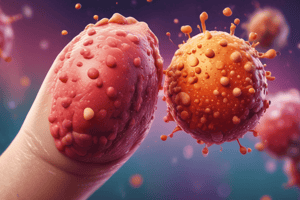Podcast
Questions and Answers
The varicella-zoster virus (VZV) establishes latency in which of the following locations?
The varicella-zoster virus (VZV) establishes latency in which of the following locations?
- Respiratory tract
- Blood stream
- Epithelial cells of the skin
- Cranial nerve or dorsal root ganglia (correct)
What is the hallmark skin lesion associated with the primary VZV infection (Varicella)?
What is the hallmark skin lesion associated with the primary VZV infection (Varicella)?
- Vesicular lesions (correct)
- Nodular lesions
- Plaque-like lesions
- Macular rash
A patient presents with a painful, vesicular rash distributed along a single dermatome. This presentation is most consistent with reactivation of which virus?
A patient presents with a painful, vesicular rash distributed along a single dermatome. This presentation is most consistent with reactivation of which virus?
- Epstein-Barr Virus
- Herpes Simplex Virus Type 1
- Human Papilloma Virus
- Varicella-Zoster Virus (correct)
Which of the following triggers is least likely to cause reactivation of the herpes simplex virus?
Which of the following triggers is least likely to cause reactivation of the herpes simplex virus?
Multinucleated giant cells are a characteristic finding in the skin pathology of which viral infection?
Multinucleated giant cells are a characteristic finding in the skin pathology of which viral infection?
Which of the following viruses is known for its ability to integrate into the host DNA, leading to keratinocyte proliferation and the formation of warts?
Which of the following viruses is known for its ability to integrate into the host DNA, leading to keratinocyte proliferation and the formation of warts?
Which type of viral infection is characterized by infecting the basal layer of the skin via micro-abrasions?
Which type of viral infection is characterized by infecting the basal layer of the skin via micro-abrasions?
Which of the following is a recognized complication of certain high-risk strains of HPV infection?
Which of the following is a recognized complication of certain high-risk strains of HPV infection?
The description "dew drop on a rose petal" is most characteristic of the lesions associated with which condition?
The description "dew drop on a rose petal" is most characteristic of the lesions associated with which condition?
Postherpetic neuralgia is a potential complication of:
Postherpetic neuralgia is a potential complication of:
A patient presents with painful grouped vesicles on an erythematous base around the mouth. Which of the following is the most likely causative agent?
A patient presents with painful grouped vesicles on an erythematous base around the mouth. Which of the following is the most likely causative agent?
Which statement accurately differentiates between Verruca vulgaris and Verruca plantaris?
Which statement accurately differentiates between Verruca vulgaris and Verruca plantaris?
What is the most accurate description of condyloma acuminata?
What is the most accurate description of condyloma acuminata?
Which of the following viruses primarily enters the body through mucosal surfaces or broken skin?
Which of the following viruses primarily enters the body through mucosal surfaces or broken skin?
In the context of viral skin infections, what does 'dermatomal distribution' refer to?
In the context of viral skin infections, what does 'dermatomal distribution' refer to?
What is the underlying mechanism by which HPV leads to the formation of warts?
What is the underlying mechanism by which HPV leads to the formation of warts?
Which of the following is a key difference in the primary infection route between VZV and HSV?
Which of the following is a key difference in the primary infection route between VZV and HSV?
Which of the following best explains the phenomenon of recurrent flares of herpes simplex virus (HSV) infections?
Which of the following best explains the phenomenon of recurrent flares of herpes simplex virus (HSV) infections?
A researcher is investigating the immunological response to HPV infection in different individuals. They observe that some individuals develop persistent HPV infections despite having detectable antibodies against the virus. Which of the following mechanisms is most likely responsible for this phenomenon?
A researcher is investigating the immunological response to HPV infection in different individuals. They observe that some individuals develop persistent HPV infections despite having detectable antibodies against the virus. Which of the following mechanisms is most likely responsible for this phenomenon?
A 70-year-old patient, who had chickenpox as a child, presents with severe burning pain and a vesicular rash on the left side of their chest following the T4 dermatome. They mention recent emotional distress due to a family issue. Which of the following cellular mechanisms is most directly involved in the reactivation of the virus in this patient?
A 70-year-old patient, who had chickenpox as a child, presents with severe burning pain and a vesicular rash on the left side of their chest following the T4 dermatome. They mention recent emotional distress due to a family issue. Which of the following cellular mechanisms is most directly involved in the reactivation of the virus in this patient?
Flashcards
Varicella-Zoster Virus (VZV)
Varicella-Zoster Virus (VZV)
A herpesvirus family member that causes varicella (chickenpox) as a primary infection and herpes zoster (shingles) upon reactivation.
Varicella (Chickenpox)
Varicella (Chickenpox)
The initial infection caused by VZV, characterized by a widespread vesicular rash.
VZV Latency
VZV Latency
The dormant phase of VZV in cranial nerve or dorsal root ganglia.
Herpes Zoster (Shingles)
Herpes Zoster (Shingles)
Signup and view all the flashcards
Herpes Simplex Virus (HSV)
Herpes Simplex Virus (HSV)
Signup and view all the flashcards
Retrograde to sensory ganglia
Retrograde to sensory ganglia
Signup and view all the flashcards
HSV Reactivation
HSV Reactivation
Signup and view all the flashcards
Multinucleated giant cells
Multinucleated giant cells
Signup and view all the flashcards
Human Papilloma Virus (HPV)
Human Papilloma Virus (HPV)
Signup and view all the flashcards
Micro-abrasions
Micro-abrasions
Signup and view all the flashcards
Keratinocyte proliferation
Keratinocyte proliferation
Signup and view all the flashcards
Warts (verrucae)
Warts (verrucae)
Signup and view all the flashcards
Immune evasion
Immune evasion
Signup and view all the flashcards
Chickenpox Prodrome
Chickenpox Prodrome
Signup and view all the flashcards
"Dew drop on a rose petal"
"Dew drop on a rose petal"
Signup and view all the flashcards
Localized pain in dermatomal pattern
Localized pain in dermatomal pattern
Signup and view all the flashcards
Postherpetic neuralgia
Postherpetic neuralgia
Signup and view all the flashcards
Verruca vulgaris
Verruca vulgaris
Signup and view all the flashcards
Verruca plantaris
Verruca plantaris
Signup and view all the flashcards
Verruca plana
Verruca plana
Signup and view all the flashcards
Study Notes
- Pathophysiology of common viral skin infections is caused by varicella-zoster virus (VZV), herpes simplex virus (HSV), and human papilloma virus (HPV).
Varicella-Zoster Virus (VZV)
- Belongs to the Herpesvirus family.
- Primary infection results in Varicella (chickenpox).
- The virus enters through the respiratory tract.
- It spreads hematogenously and infects epithelial cells of the skin.
- Causes vesicular lesions over the trunk, scalp, and face.
- Latency: The virus lies dormant in cranial nerve or dorsal root ganglia.
- Reactivation: Occurs due to stress, aging, or immunosuppression, resulting in Herpes Zoster (shingles).
- The virus travels down the sensory nerve to the skin, causing a painful vesicular rash in a dermatomal distribution.
Herpes Simplex Virus (HSV-1 and HSV-2)
- Is an enveloped DNA virus.
- HSV-1 is more commonly oral.
- HSV-2 is more commonly genital.
- Primary Infection: Enters through mucosal surfaces or broken skin.
- Replicates locally and travels retrograde to sensory ganglia, becoming latent.
- Reactivation trigger includes stress, UV light, and illness.
- The virus reactivates and travels back to the skin, causing recurrent vesicular lesions.
- Skin pathology results in a viral cytopathic effect that includes multinucleated giant cells, ballooning degeneration, and necrosis in the epidermis.
Human Papilloma Virus (HPV)
- Is a non-enveloped DNA virus with tropism for epithelial cells.
- Infection: Infects the basal layer of skin/mucosa via micro-abrasions.
- Integrates into host DNA, promoting keratinocyte proliferation.
- Forms warts (verrucae), which are benign epidermal tumors.
- Immune Evasion involves a limited inflammatory response allowing persistent infection.
- Oncogenic strains, such as HPV 16 and 18, can cause dysplasia and malignancy in mucosal sites, such as cervical cancer.
Chickenpox (Primary VZV Infection)
- Prodrome: Fever, malaise, and anorexia.
- Rash:
- Begins on the trunk and spreads to the face and extremities.
- Causes "dew drop on a rose petal" lesions (clear vesicles on an erythematous base).
- Lesions are in different stages: macules, papules, vesicles, and crusts.
- It is contagious 24 hours before the rash until crusting of lesions, which takes approximately 5–7 days.
Shingles (Herpes Zoster)
- Features localized pain (burning, tingling) in a dermatomal pattern.
- Followed by vesicular eruption on an erythematous base.
- Common sites are thoracic and trigeminal dermatomes.
- May lead to postherpetic neuralgia (chronic nerve pain).
Herpes Simplex Virus
- Primary infection involves painful grouped vesicles on an erythematous base.
- Often appears around the mouth (HSV-1) or genitals (HSV-2).
- Recurrent lesions are milder and may include tingling or burning prodrome.
- May ulcerate and crust over.
Human Papilloma Virus (HPV)
- Causes cutaneous warts:
- Verruca vulgaris: Common warts are firm, hyperkeratotic papules on the hands and fingers
- Verruca plantaris: Painful warts on the soles of the feet
- Verruca plana: Flat, smooth papules on the face and hands
- Causes mucosal warts: Condyloma acuminata are soft, pink, cauliflower-like growths in the genital/anal region.
Studying That Suits You
Use AI to generate personalized quizzes and flashcards to suit your learning preferences.





